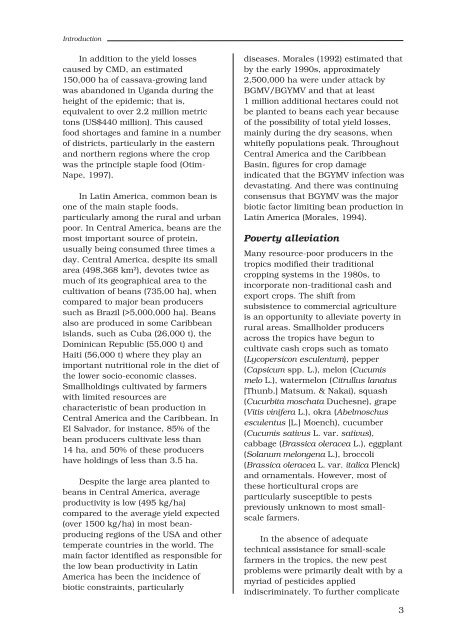Whitefly and whitefly-borne viruses in the tropics : Building a ... - cgiar
Whitefly and whitefly-borne viruses in the tropics : Building a ... - cgiar
Whitefly and whitefly-borne viruses in the tropics : Building a ... - cgiar
You also want an ePaper? Increase the reach of your titles
YUMPU automatically turns print PDFs into web optimized ePapers that Google loves.
Introduction<br />
In addition to <strong>the</strong> yield losses<br />
caused by CMD, an estimated<br />
150,000 ha of cassava-grow<strong>in</strong>g l<strong>and</strong><br />
was ab<strong>and</strong>oned <strong>in</strong> Ug<strong>and</strong>a dur<strong>in</strong>g <strong>the</strong><br />
height of <strong>the</strong> epidemic; that is,<br />
equivalent to over 2.2 million metric<br />
tons (US$440 million). This caused<br />
food shortages <strong>and</strong> fam<strong>in</strong>e <strong>in</strong> a number<br />
of districts, particularly <strong>in</strong> <strong>the</strong> eastern<br />
<strong>and</strong> nor<strong>the</strong>rn regions where <strong>the</strong> crop<br />
was <strong>the</strong> pr<strong>in</strong>ciple staple food (Otim-<br />
Nape, 1997).<br />
In Lat<strong>in</strong> America, common bean is<br />
one of <strong>the</strong> ma<strong>in</strong> staple foods,<br />
particularly among <strong>the</strong> rural <strong>and</strong> urban<br />
poor. In Central America, beans are <strong>the</strong><br />
most important source of prote<strong>in</strong>,<br />
usually be<strong>in</strong>g consumed three times a<br />
day. Central America, despite its small<br />
area (498,368 km 2 ), devotes twice as<br />
much of its geographical area to <strong>the</strong><br />
cultivation of beans (735,00 ha), when<br />
compared to major bean producers<br />
such as Brazil (>5,000,000 ha). Beans<br />
also are produced <strong>in</strong> some Caribbean<br />
isl<strong>and</strong>s, such as Cuba (26,000 t), <strong>the</strong><br />
Dom<strong>in</strong>ican Republic (55,000 t) <strong>and</strong><br />
Haiti (56,000 t) where <strong>the</strong>y play an<br />
important nutritional role <strong>in</strong> <strong>the</strong> diet of<br />
<strong>the</strong> lower socio-economic classes.<br />
Smallhold<strong>in</strong>gs cultivated by farmers<br />
with limited resources are<br />
characteristic of bean production <strong>in</strong><br />
Central America <strong>and</strong> <strong>the</strong> Caribbean. In<br />
El Salvador, for <strong>in</strong>stance, 85% of <strong>the</strong><br />
bean producers cultivate less than<br />
14 ha, <strong>and</strong> 50% of <strong>the</strong>se producers<br />
have hold<strong>in</strong>gs of less than 3.5 ha.<br />
Despite <strong>the</strong> large area planted to<br />
beans <strong>in</strong> Central America, average<br />
productivity is low (495 kg/ha)<br />
compared to <strong>the</strong> average yield expected<br />
(over 1500 kg/ha) <strong>in</strong> most beanproduc<strong>in</strong>g<br />
regions of <strong>the</strong> USA <strong>and</strong> o<strong>the</strong>r<br />
temperate countries <strong>in</strong> <strong>the</strong> world. The<br />
ma<strong>in</strong> factor identified as responsible for<br />
<strong>the</strong> low bean productivity <strong>in</strong> Lat<strong>in</strong><br />
America has been <strong>the</strong> <strong>in</strong>cidence of<br />
biotic constra<strong>in</strong>ts, particularly<br />
diseases. Morales (1992) estimated that<br />
by <strong>the</strong> early 1990s, approximately<br />
2,500,000 ha were under attack by<br />
BGMV/BGYMV <strong>and</strong> that at least<br />
1 million additional hectares could not<br />
be planted to beans each year because<br />
of <strong>the</strong> possibility of total yield losses,<br />
ma<strong>in</strong>ly dur<strong>in</strong>g <strong>the</strong> dry seasons, when<br />
<strong>whitefly</strong> populations peak. Throughout<br />
Central America <strong>and</strong> <strong>the</strong> Caribbean<br />
Bas<strong>in</strong>, figures for crop damage<br />
<strong>in</strong>dicated that <strong>the</strong> BGYMV <strong>in</strong>fection was<br />
devastat<strong>in</strong>g. And <strong>the</strong>re was cont<strong>in</strong>u<strong>in</strong>g<br />
consensus that BGYMV was <strong>the</strong> major<br />
biotic factor limit<strong>in</strong>g bean production <strong>in</strong><br />
Lat<strong>in</strong> America (Morales, 1994).<br />
Poverty alleviation<br />
Many resource-poor producers <strong>in</strong> <strong>the</strong><br />
<strong>tropics</strong> modified <strong>the</strong>ir traditional<br />
cropp<strong>in</strong>g systems <strong>in</strong> <strong>the</strong> 1980s, to<br />
<strong>in</strong>corporate non-traditional cash <strong>and</strong><br />
export crops. The shift from<br />
subsistence to commercial agriculture<br />
is an opportunity to alleviate poverty <strong>in</strong><br />
rural areas. Smallholder producers<br />
across <strong>the</strong> <strong>tropics</strong> have begun to<br />
cultivate cash crops such as tomato<br />
(Lycopersicon esculentum), pepper<br />
(Capsicum spp. L.), melon (Cucumis<br />
melo L.), watermelon (Citrullus lanatus<br />
[Thunb.] Matsum. & Nakai), squash<br />
(Cucurbita moschata Duchesne), grape<br />
(Vitis v<strong>in</strong>ifera L.), okra (Abelmoschus<br />
esculentus [L.] Moench), cucumber<br />
(Cucumis sativus L. var. sativus),<br />
cabbage (Brassica oleracea L.), eggplant<br />
(Solanum melongena L.), broccoli<br />
(Brassica oleracea L. var. italica Plenck)<br />
<strong>and</strong> ornamentals. However, most of<br />
<strong>the</strong>se horticultural crops are<br />
particularly susceptible to pests<br />
previously unknown to most smallscale<br />
farmers.<br />
In <strong>the</strong> absence of adequate<br />
technical assistance for small-scale<br />
farmers <strong>in</strong> <strong>the</strong> <strong>tropics</strong>, <strong>the</strong> new pest<br />
problems were primarily dealt with by a<br />
myriad of pesticides applied<br />
<strong>in</strong>discrim<strong>in</strong>ately. To fur<strong>the</strong>r complicate<br />
3
















